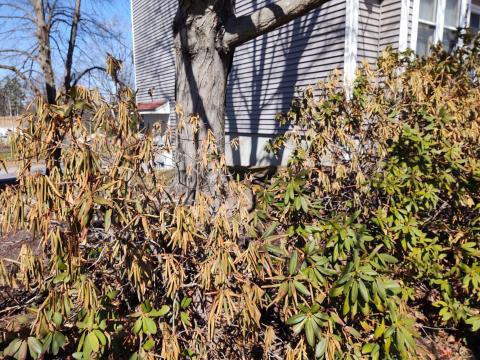
With the arrival of warm weather it is becoming clear that many broadleaf evergreens were damaged over the winter, much like they were two years ago. Most people have noticed that some of the branches on their rhododendrons have curled leaves that don’t open on warm days, indicating they have been injured in some way. Many hollies are also burned brown leaves above where the snowline would have been. In most cases much of the damage appears to have occurred at random. While a few scattered branches may have been injured on a plant, the rest are seemingly healthy. Even adjacent plants often fared differently, with one suffering significant damage, whereas the other is unscathed.
The most likely explanation for this phenomenon is winter injury. Broadleaf evergreens, such as rhododendrons, lose water through their leaves even in winter when the weather is relatively warm and sunny or during periods of high winds. When the ground is frozen, the roots aren’t able to take up enough water in the soil to make-up for what is lost through the leaves. The leaves curl and droop and may turn brown at the tips and edges. Curling their leaves is a protective mechanism against dehydration during cold periods, and normally the leaves unfurl when it warms up. More often than not, damage that occurred over the winter does not become apparent until the spring. This past winter was exceptionally windy by any standard, which likely precipitated the dieback noticed on many rhododendrons.
Explaining why winter injury often occurs in random patterns is difficult to explain. In many places there was very little protective snow cover on the ground. Snow acts as an insulator, protecting leaves that are underneath the snow, and helps moderate the soil temperature. The state of different rhododendrons may also have to do with variety. Many hybrid rhododendrons, which are very popular as landscape plants, are not as cold hardy as species types.
Repairing Damage
If you believe that your rhododendrons suffered from winter injury, the best thing you can do now is wait to see if any of the damaged branches survived. It’s possible to sustain leaf damage without the branch and buds being killed. If slightly scraping the outer layer of bark reveals green, the branch is still alive and likely to recover. Branches that don’t show any signs of life once growth resumes in the coming weeks and months should be pruned out. Buds are generally hardier than leaves and are much better at surviving extreme weather conditions. By the end of June, rhododendrons should have produced new leaves, at which point dead branches should be removed.
Prevention
In the future, you can try to prevent winter injury in a few ways. Proper care during the growing season is a crucial part of keeping rhododendrons alive through the winter. Providing adequate water is essential. For optimum growth, most rhododendrons require one inch of rainfall or supplemental irrigation every week. Fall watering is extremely important and should continue until the temperature drops below 40 degrees. Also avoid fertilizing after mid-September because it may delay dormancy.
Many winter injury issues can be solved by choosing appropriate plants. Hardiness is the first thing to consider. Rhododendrons should be hardy enough to survive in the zone they are planted without too much extra care. In most of New Hampshire, this means selecting plants which are hardy in zones 3-5.
Location is just as important as plant selection. Since harsh winter winds and sun can damage rhododendrons, they should be planted in partially shady areas where they are protected from prevailing winds. Generally speaking, avoid planting in dry soil, full sun, or on exposed windy sites. Avoid exposed southern or western sites where winter sun and wind will cause the most damage.
Other important measures include mulching or using physical barriers such as burlap to block the wind. Mulching rhododendrons, especially those that have been newly planted, insulates the soil and protects the plant’s roots. At least two inches of woodchips or straw should be applied over the root zone, taking care not to pile the mulch against the trunk. Creating windbreaks from materials such as burlap or canvas may also help.
Do you love learning about stuff like this?
SUBSCRIBE TO GRANITE STATE GARDENING
A monthly newsletter for New Hampshire gardeners, homesteaders and plant-lovers of all kinds, that includes seasonal suggested gardening tips, upcoming events and articles with proven solutions for your garden and landscape.
Got questions? The Ask UNH Extension Infoline offers practical help finding answers for your home, yard, and garden questions. Call toll free at 1-877-398-4769, Monday to Friday, 9 a.m. to 2 p.m., or e-mail us at answers@unh.edu.

